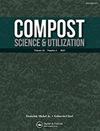Spent Mushroom Compost of Pleurotus ostreatus: A Tool to Treat Soil Contaminated with Endosulfan
IF 0.9
4区 农林科学
Q3 ECOLOGY
引用次数: 2
Abstract
Abstract Composts especially spent mushroom composts (SMC) have been used for their ability to degrade toxic organic pollutants. Due to extreme toxicity, endosulfan (C9H6Cl6O3S) is categorized as a Category 1 pollutant by the U.S. EPA because of its well-reported carcinogenicity. This study was done to monitor the biodegradation potential of SMC against this pesticide. For this purpose, bioreactors (BRs) system was designed to mimic the field conditions. Soil within all four BRs contaminated with endosulfan was amended with four different treatments of SMC. Quantitative reduction in amount of endosulfan isomers was calculated using Gas Chromatography–Electron Capture Detector. For the monitoring of metabolites formed as a result of biodegradation, Gas Chromatography–Mass Spectrometry was used. Maximum attenuation was observed in BR1 (fresh SMC and soil). In BR2 when fresh SMC was added in sterilized soil, rate of removal was declined as compared to BR1. In another bioreactor BR3, where unsterilized soil was used with sterilized SMC, total reduction in quantity of endosulfan was less than BR1 and BR2. BR4 (abiotic control) showed the least reduction suggesting the role of SMC and soil microbes. Degradation was well described using simple first-order kinetics which revealed that the active microcosm of BR1 manifested least DT50. Denaturation of either SMC(BR3) or soil(BR2) or both (BR4) resulted in less biodegradation than BR1.平菇废菌堆肥:处理硫丹污染土壤的工具
摘要堆肥,特别是废蘑菇堆肥(SMC)因其降解有毒有机污染物的能力而得到广泛应用。由于极具毒性,硫丹(C9H6Cl6O3S)因其致癌性被美国环保局列为1类污染物。本研究旨在监测SMC对该农药的生物降解潜力。为此,设计了生物反应器(BRs)系统来模拟现场条件。采用四种不同的SMC处理对四种受硫丹污染的土壤进行了改良。采用气相色谱-电子捕获检测器计算硫丹异构体的定量还原量。为了监测由于生物降解而形成的代谢物,使用了气相色谱-质谱法。在BR1(新鲜SMC和土壤)中衰减最大。在BR2中,与BR1相比,在灭菌土壤中添加新鲜SMC时,去除率下降。在另一个生物反应器BR3中,未灭菌的土壤与灭菌的SMC一起使用,硫丹的总减少量小于BR1和BR2。BR4(非生物对照)减少最少,提示SMC和土壤微生物的作用。用简单的一级动力学很好地描述了降解,这表明BR1的活性微观表现出最小的DT50。SMC(BR3)或土壤(BR2)或两者(BR4)的变性均比BR1的生物降解程度低。
本文章由计算机程序翻译,如有差异,请以英文原文为准。
求助全文
约1分钟内获得全文
求助全文
来源期刊

Compost Science & Utilization
农林科学-生态学
CiteScore
4.10
自引率
0.00%
发文量
0
审稿时长
>36 weeks
期刊介绍:
4 issues per year
Compost Science & Utilization is currently abstracted/indexed in: CABI Agriculture & Environment Abstracts, CSA Biotechnology and Environmental Engineering Abstracts, EBSCOhost Abstracts, Elsevier Compendex and GEOBASE Abstracts, PubMed, ProQuest Science Abstracts, and Thomson Reuters Biological Abstracts and Science Citation Index
 求助内容:
求助内容: 应助结果提醒方式:
应助结果提醒方式:


